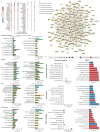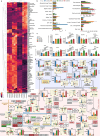Temporal analysis of doxorubicin-induced cardiac toxicity and hypertrophy
- PMID: 40593928
- PMCID: PMC12219892
- DOI: 10.1038/s41540-025-00545-7
Temporal analysis of doxorubicin-induced cardiac toxicity and hypertrophy
Abstract
Doxorubicin (DOX), although effective in treating cancer, has significant cardiac side effects, which limit its clinical utility. In this study, we collected time-course transcriptomics and metabolomics data from the human cardiomyocyte cell line AC16, which we analyzed along with curated public transcriptomics data on DOX-induced toxicity. We developed a multiomics analysis workflow and a computational toolbox, pipeGEM, to integrate RNA-seq data with metabolic models, enabling the simulation of DOX-induced metabolic perturbations at a sample-specific level. Our results revealed that DOX affected mitochondrial damage and mitochondria-to-nucleus retrograde signaling, potentially contributing to the observed cellular enlargement, senescence and metabolic shift. Cardiac cells that survived DOX treatment presented elevated glycolysis, increased pentose phosphate pathway activity, an altered TCA cycle, and modified glutathione and fatty acid metabolism. These findings provide a comprehensive understanding of DOX-induced toxicity and its implications for cardiac hypertrophy, suggesting potential strategies to mitigate side effects while retaining the anticancer efficacy of DOX.
© 2025. The Author(s).
Conflict of interest statement
Competing interests: The authors declare no competing interests.
Figures










Similar articles
-
The function of PCSK9 in doxorubicin-induced cardiotoxicity and its underlying mechanism.Sci Rep. 2025 Jul 1;15(1):22067. doi: 10.1038/s41598-025-03419-4. Sci Rep. 2025. PMID: 40593844 Free PMC article.
-
Network pharmacology and experimental verification: Rosmarinic acid alleviates doxorubicin-induced cardiomyocyte apoptosis by regulating BCL2L1.Hum Exp Toxicol. 2025 Jan-Dec;44:9603271251354890. doi: 10.1177/09603271251354890. Epub 2025 Jul 2. Hum Exp Toxicol. 2025. PMID: 40600628
-
Circular RNAs as regulatory mediators and therapeutic targets in doxorubicin-induced cardiotoxicity.Curr Probl Cardiol. 2025 Sep;50(9):103106. doi: 10.1016/j.cpcardiol.2025.103106. Epub 2025 Jun 13. Curr Probl Cardiol. 2025. PMID: 40517831 Review.
-
Neuraminidase 1 Exacerbated Glycolytic Dysregulation and Cardiotoxicity by Destabilizing SIRT1 through Interactions with NRF2 and HIF1α.Adv Sci (Weinh). 2025 Jul;12(25):e2414504. doi: 10.1002/advs.202414504. Epub 2025 May 24. Adv Sci (Weinh). 2025. PMID: 40411250 Free PMC article.
-
Topotecan, pegylated liposomal doxorubicin hydrochloride and paclitaxel for second-line or subsequent treatment of advanced ovarian cancer: a systematic review and economic evaluation.Health Technol Assess. 2006 Mar;10(9):1-132. iii-iv. doi: 10.3310/hta10090. Health Technol Assess. 2006. PMID: 16545208
References
-
- Davies, K. J. & Doroshow, J. H. Redox cycling of anthracyclines by cardiac mitochondria. I. Anthracycline radical formation by NADH dehydrogenase. J. Biol. Chem.261, 3060–3067 (1986). - PubMed
-
- Doroshow, J. H. & Davies, K. J. Redox cycling of anthracyclines by cardiac mitochondria. II. Formation of superoxide anion, hydrogen peroxide, and hydroxyl radical. J. Biol. Chem.261, 3068–3074 (1986). - PubMed
-
- Larsen, R. L. et al. Electrocardiographic changes and arrhythmias after cancer therapy in children and young adults. Am. J. Cardiol.70, 73–77 (1992). - PubMed
-
- Steinberg, J. S., Cohen, A. J., Wasserman, A. G., Cohen, P. & Ross, A. M. Acute arrhythmogenicity of doxorubicin administration. Cancer60, 1213–1218 (1987). - PubMed
-
- Von Hoff, D. D. et al. Risk factors for doxorubicin-induced congestive heart failure. Ann. Intern. Med.91, 710–717 (1979). - PubMed
MeSH terms
Substances
Grants and funding
LinkOut - more resources
Full Text Sources

